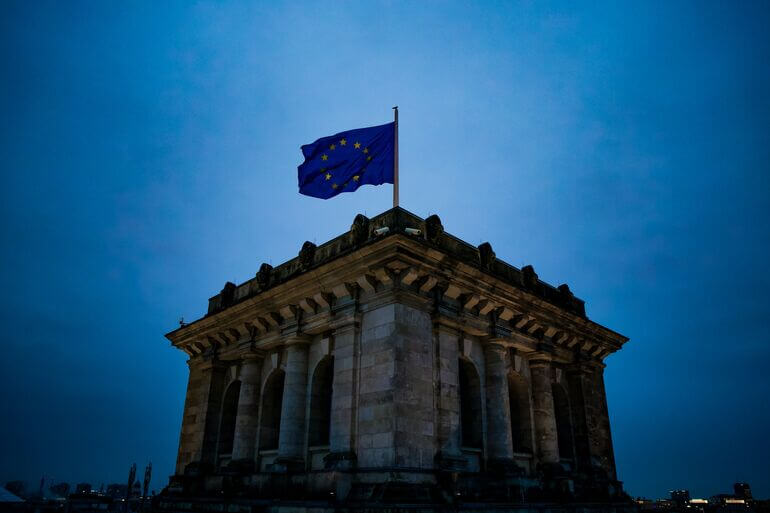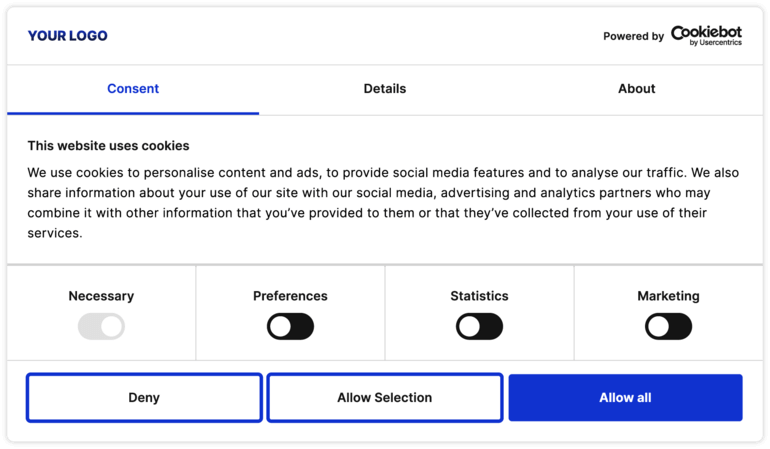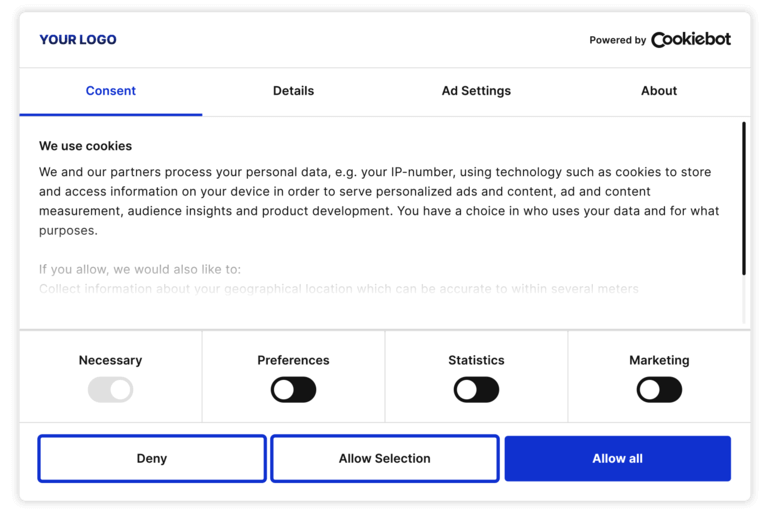Quick summary
EDPB guidelines in brief
On May 4, 2020, the European Data Protection Board (EDPB) adopted guidelines for GDPR compliance that clarify what constitutes valid consent for personal data processing in the EU, and confirm that the use of “cookie walls” as a way of obtaining consent is non-compliant.
These EDPB guidelines cement as a unified application of the GDPR what several national data protection authorities and the CJEU Planet49 ruling have independently ruled. Because EDPB’s guidelines direct how DPAs in each EU member state are to enforce the GDPR, it is very important to take notice of these.
Read the EDPB guidelines 05/2020 on valid consent here.
Test if your website is compliant with EDPB guidelines and GDPR for free.
Try Cookiebot CMP free for 14 days... or forever if you have a small website.
EDPB guidelines on valid consent
For a consent to be valid according to the GDPR, it has to be:
- Freely given
- Specific
- Informed
- Unambiguous
EDPB clarifies in its guidelines that “an unambiguous indication of user consent” must be made with a clear and affirmative action by the user.
User actions such as scrolling or swiping through a website or similar user activity (also known as implied consent) do not meet the requirement for valid consent under the GDPR.
With the EDPB guidelines, this means that your website’s cookie banner is not allowed to state that continued browsing or scrolling on your domain will be considered a consent to the use of cookies that process personal data, as this is not a valid form of consent under the GDPR.
Instead, your website’s cookie banner must be interactive and the website must refrain from activating any cookies that collect personal data, until the user has selected which categories of cookies, they will allow to be in operation (known as prior consent).
The EDPB guidelines also clarify that the use of pre-ticked opt-in boxes is not GDPR compliant, as this does not live up to the “clear and affirmative action” requirement either.
Here, the EDPB guidelines complement the legal precedent made by the Court of Justice of the European Union (CJEU) in the case of Planet 49 in October 2019.
This CJEU decision ruled that pre-ticked boxes on cookie banners are not allowed, since they also don’t live up to the requirement that consent has to be a freely given, affirmative action.
Learn more about CJEU and the case of Planet49
Try Cookiebot CMP for free today… or forever if you have a small website.

EDPB guidelines on cookie walls
EDPB guidelines also clarify that a “cookie wall” is a non-compliant way of obtaining consent for websites.
Cookie walls work by making access to websites conditional on the user’s consent to the processing of their personal data, and the EDPB guidelines state very clearly that this does not constitute valid consent.
Since a cookie wall operates by forcing a consent from users to store cookies or accessing already stored cookies in exchange for access to services and functionalities, cookie walls as a way of obtaining consent does not live up to the GDPR requirement that a valid consent has to be freely given and on the basis of a genuine choice.
Want to know more about cookie walls?
What do the EDPB guidelines mean for my website?
The EDPB guidelines cement what has been the intention of the GDPR all along: to empower the users with real, enforceable rights over their own data and privacy.
In their guidelines on consent, the EDPB makes it very clear that any kind of attempt to avoid giving users real power over their own personal data (such as forcing consent or relying on poorly informed implied consents) will not be tolerated.
In other words, your website is not allowed to activate any cookies that process personal data unless the user has given their clear and affirmative consent to it.
For your website, this means –
- No pre-ticked checkboxes on your cookie banners
- Scrolling and continued browsing is not valid consent
- Cookie walls are non-compliant for obtaining consent
If your website uses a consent solution that activates cookies on the basis of continued scrolling, clicking or browsing on your website (i.e. any other activity than direct, explicit interaction with the consent banner), uses pre-ticked checkboxes or cookie walls, you need to change this.
The EDPB guidelines form the basis for all GDPR enforcement on a national level by the respective data protection authorities in each EU member state, so if your website is operating from an EU country or if your website processes personal data on individuals from an EU country, you must be in compliance with the EDPB guidelines on GDPR compliance.
EDPB guidelines and GDPR compliance test
Not sure if your website lives up to GDPR requirements for lawful use of cookies and trackers? In doubt whether your domain meets the EDPB guidelines for valid consent?
Cookiebot CMP performs a free scan of your website that detects all cookies and trackers in operation on your domain.
You might find that your website has many more cookies than you are aware of, since –
72% of cookies are secretly loaded by third-party trackers, making them almost impossible to detect without proper scanning technology.
18% of cookies on websites are trojan horses, i.e. trackers that load from as deep as within eight other cookies.
50% of all trojan horses will change between visits, so users risk having their personal data harvested by different third parties on your website, when they visit your domain again.
Source: Beyond the Front Page, a 2020 research paper on website cookies.
Test your website’s GDPR and EDPB guidelines compliance for free
Learn more about GDPR and cookie consent
Try Cookiebot CMP for free today
Cookiebot CMP and EDPB guidelines
Cookiebot CMP is the world’s leading consent management platform that makes your website compliant with the all major data protection laws.
The Cookiebot CMP solution is plug and play with no need for manual implementation or on-site integration with your domain.
Simply implement Cookiebot CMP from the cloud to protect the privacy of your users from third-party data abuse.
Cookiebot CMP performs deep-scans of your entire website to detect all cookies and trackers in operation – even the hidden trojan horses – and auto-blocks everything until your users have given their prior consent, in full compliance with the GDPR.
The Cookiebot CMP consent solution is in full compliance with the EDPB guidelines on valid consent:
- auto-blocking of all cookies and trackers for prior consent
- granular, affirmative choice of consent on four categories of cookies
- full cookie declaration of provider, purpose, duration and type of each cookie
- simple way for users to change or withdraw consent
- securely documented user consent
- automatic renewal of user consent

Try Cookiebot CMP free for 14 days… or forever if you have a small website.
EDPB guidelines in detail
The EDPB guidelines 05/2020 on valid consent is a detailed 33-page document that was adopted on May 4, 2020.
In the rest of this article, we will take a closer look at each of the important sections of the EDPB guidelines that clarify valid consent under the GDPR:
- Freely given consent
- Conditionality of consent
- Granular consent
- Specific consent
- Informed consent
- Withdrawal of consent
- Additional conditions for obtaining valid consent
- Data subject’s rights
Read the EDPB guidelines in full here.
Who is the EDPB?
The European Data Protection Board (EDPB) is the leading supervisory authority responsible for the consistent application of the General Data Protection Regulation (GDPR) in the EU.
EDPB was established with the passing of the GDPR into law in 2018 and is comprised of representatives from the national data protection authorities in each EU member state.
The EDPB’s job consists of adopting general guidelines and making decisions that clarify how the GDPR is supposed to be interpreted by websites, companies and organizations for full compliance.
EDPB guidelines and decisions are the cornerstone in the enforcement of the GDPR in EU member states, where each national data protection authority is responsible for the GDPR’s application.
Freely given consent
When obtaining consent from users to the activation of cookies that process personal data, your website must make sure that it is freely given – a cornerstone for valid consent in the GDPR.
If the user has no real choice, feels compelled to consent or will suffer negative consequences if they do not consent (such as lowered services or access denied), then the consent will not be valid.
Your website is not allowed to bundle consent, i.e. if consent is presented as a non-negotiable part of terms and conditions, it is presumed not to have been freely given.
Accordingly, consent will not be considered to be valid if the user is unable to refuse or withdraw consent without consequences (such as lowered quality of services or access denial).
Conditionality of consent
As briefly touched upon above, to bundle consents is not compliant, the EDPB guidelines clarify.
To make consent conditional to e.g. acceptance of terms or conditions, or the performance of a service to which the personal data processed by cookies and trackers is not necessary, is considered an invalid form of consent.
The GDPR contains six legal bases for the processing of personal data, of which the first is with the consent of the user and the second is for the performance of a contract.
EDPB guidelines make it very clear that these two legal bases cannot be merged or blurred, i.e. if your website relies on user consent for the use of cookies and trackers that process personal data, this consent cannot be conditioned on the performance of a service that does not need the personal data to be performed (see GDPR article 7, 4 for more on this).
This is the part of the EDPB guidelines that effectively rules out the use of cookie walls as a compliant form of obtaining consent, since a forced consent is not freely given (read: valid).
Compulsion to agree to non-necessary personal data collection stand in the way of free consent, the EDPB guidelines clarify.
Learn more about cookie walls here
Granular consent
Most websites in the world have a lot of different cookies in operation, each one collecting different data for different purposes by different providers.
The EDPB guidelines clarify that if your website processes personal data for more than one purpose, users must be able to freely choose which purpose they accept – rather than having to consent to a bundle of processing purposes.
This means for your website that you must know all cookies and their different purposes, and offer users the possibility of selecting the activation of some cookies and not others, also known as granular consent.

Specific consent
Valid consent, the EDPB guidelines clarify, must be specific, i.e. clear determination of a specific, explicit and legitimate purpose for the intended processing activity.
To comply with the GDPR requirement for a consent to be specific, your website must ensure –
- Purpose specification as a safeguard against function creep (i.e. that personal data is used for multiple purposes without the specific consent of the user for each purpose).
- Granularity in consent requests
- Clear separation of information related to obtaining consent for data processing activities from information about other matters
Informed consent
EDPB guidelines clarify that valid consent must be informed, i.e. users must know and understand what they are consenting to.
Your website must live up to these minimum content requirements for consent to be informed –
- You and your website’s identity,
- Purpose of each of the processing operations for which consent is sought on your website,
- What type of data will be collected and used on your website,
- The existence of the right to withdraw consent,
- Information about the use of the data for automated decision-making,
- The possible risks of data transfers due to absence of an adequacy decision and of appropriate safeguards as described in Article 46.
Your information to your users must be written in clear and plain language and be easily understandable for the average person (and not only for lawyers).

Withdrawal of consent
If your website relies on consent for personal data processing done by the use of cookies and trackers, you must be prepared to respect users’ choices to withdraw that consent. This is a GDPR requirement.
Users must be able to withdraw their consent just as easily as they gave it. It is actually a condition for the validity of a consent that the user has an equally easy way of withdrawing it afterwards.
Users must be able to withdraw their consent freely and without consequences, such as having their access to a website denied or experience a lowering of services.
All personal data processing that took place after the user consented and before the withdrawal of the consent is lawful.
Additional conditions for obtaining valid consent
The burden of proof to demonstrate user consent for personal data processing is on the website owner and/or operator.
This means that you will need to be able to demonstrate that the user has given consent to your website setting cookies and trackers that collect personal data. Documentation of consent must be securely stored.
EDPB recommends as best practice that consents should be refreshed at appropriate intervals.
Data subject's rights
Lastly, remember that your users have GDPR secured rights that you must always respect in order to be compliant.
They are –
- The right to erasure of collected and stored personal data, when consent has been withdrawn
- The right to restriction
- The right to rectification
- The right to access
- The right to data portability
Cookiebot CMP and GDPR compliance
Cookiebot CMP takes care of all the GDPR compliance requirements that your website must meet, when using cookies that process personal data of users inside the EU.
- Scans and finds all cookies and trackers, even the hidden trojan horses
- Automatically blocks all until the user has given specific, granular consent
- Documents and securely stores each obtained consent
- Automatically renews consents.
Learn more about GDPR compliance
See all Cookiebot CMP features
See all Cookiebot CMP pricing plans
Take the free Cookiebot CMP GDPR compliance test
Try Cookiebot CMP for free today
FAQ
The European Data Protection Board (EDPB) is the highest supervisory body in charge of application and enforcement of the General Data Protection Regulation (GDPR) in the EU. The EDPB is comprised of representatives from the data protection authorities in each EU member state, and their main function is to adopt general guidelines and make decisions on how the GDPR is to be interpreted and enforced.
Try Cookiebot CMP free for 14 days... or forever if you have a small website.
The EDPB guidelines on valid consent from May 2020 clarify what constitutes valid consent, when relying on user consent for the processing of personal data, e.g. through the use of cookies and trackers on websites. The EDPB guidelines rules out the use of cookie walls (forced consent) and specifies what websites must do in order to obtain a valid consent to the processing of personal data.
Test your website's compliance with the free Cookiebot CMP GDPR compliance test
EDPB guidelines 05/2020 clarify that valid consent is a freely given, informed, specific and unambiguous indication of a user’s wishes. This means that your website must give users a real choice of consent between all different cookies and trackers, prior to their activation and personal data processing. Scrolling and continued browsing on websites is not valid consent and cookie banners are not allowed to have pre-ticked checkboxes.
First, you must know of all cookies and trackers in operation on your website, so that you can inform users of their type, purpose, duration and provider. Secondly, you must block all cookies (apart from necessary cookies) until the users have given their clear and affirmative consent to which they will allow activated. Thirdly, you must document all consents securely and renew them annually. Fourthly, you must make it as easy for the user to withdraw their consent as it was for them to give it in the first place.
Resources
European Data Protection Board (EDPB)
EDPB guidelines 05/2020 on valid consent
Beyond the Front Page, a 2020 research paper of website cookies and tracking